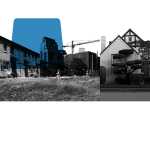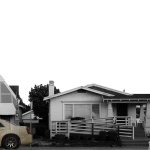Michelle Wilde Anderson asks what a city can do to further healthy housing initiatives. This question has become more urgent as national leaders have committed to spending fewer public dollars on health and housing, and to pursuing policies where those dollars are distributed by entities below the federal level (e.g., block grants).
In this climate, local institutions and advocates must assess what sort of advocacy will be effective in ensuring that government does not withdraw from its important role in securing the essential benefits. They should also evaluate the opportunities presented by the current environment- to take advantage of less oversight and regulation at the federal level and to push health and housing policy at the local level.
The point of this brief essay is to argue that litigation is and should always be a weapon for in the advocacy arsenal of community institutions and groups seeking to effect change. Many who face challenges in achieving their health and housing program and policy goals do not see themselves in an advocacy role, and may see advocacy tools like litigation as adversarial or inconsistent with their institutional values. However, if advocacy is understood more expansively, litigation can be a natural and effective component of an overall approach to community empowerment. So how then to best use litigation within a broader advocacy strategy?
Litigation can be a natural and effective component of an overall approach to community empowerment.
First, I would argue that the goal of advocacy at this point should not be to maintain the status quo, but rather to ensure that, as we move toward a more local focus to our work, we encourage innovation and experimentation to address the longstanding problems we continue to face in spite of decades of work. These community-specific solutions should not allow for either a reduction (as opposed to redirecting) or inequitable distribution of financial and other tangible resources. Secondly, local institutions and communities should be open to litigation as a tool to promote health and housing. Making the most of this tool means ensuring that lawyers are involved from the beginning so that the full range of advocacy strategies are understood early on.
Institutions whose primary role is to deliver services related to health and/or housing will be more effective if they vet their perceptions about the problem that advocacy — including litigation — is meant to address. A good community engagement program that explores the nature and extent of problems, in conjunction with quality data, should be utilized. People tend to know a lot about how a problem is affecting them, and may have an idea about who is the source of the problem, but without robust research and education, the underlying causes may go unexamined, and the solutions sought may be superficial and ineffective.
Working with the community, an institution can conduct an inventory of what the community has now that it doesn’t want to lose, and what it needs/wants that it doesn’t now have. Even (or especially) friends may say they just don’t have the money to do what you say needs to be done, and to some extent that will always be true. But, there is always some money, and someone is allocating it in certain ways. Maybe the problem is not a lack of resources, but a lack of political will to direct those resources appropriately.
With political will, resources could be redirected from one underperforming place to another, which would demonstrate that money — appropriately deployed — can make a difference. This means getting into the budget process of the local institutions that allocate resources, and understanding where the money, as well as the bodies, are buried. Sometimes the community institution must engage in its own self-examination, and be willing to be accountable for the use of their own resources in response to community feedback.
Local community institutions and community advocates can help insure that legal strategies are grounded in a robust understanding of the problem and who has the ability to deliver the most effective remedies.
Advocates should not get seduced into to excusing local behavior because of a plea of lack of money from higher up. Institutions and community advocates should be clear-eyed about the fact that power to do harm and do good lies at every level. However, there may be strategic reasons to work with the local jurisdiction to go after the entities with the deeper pockets. This can mean going up the food chain to focus on holding those with the most power the most accountable. This is where litigation can come in.
The basis for litigation will depend on the issue and context. Federal law is often implicated given the federal resources involved in housing and health. For example, the Supreme Court recently affirmed that cities can sue banks for predatory lending and redlining under the Fair Housing Act. State and local law may also be useful, depending on the issue and jurisdictions involved. While prevailing in Federal cases will not be easy, it gives local jurisdictions a “stick” that they did not have before and it gives advocates a potential ally in seeking a remedy for discriminatory conduct.
At the very least, the institutional advocacy team should include a lawyer, preferably from the outset. Local community institutions and community advocates can help insure that legal strategies are grounded in a robust understanding of the problem and who has the ability to deliver the most effective remedies. There are always concerns that lawyers not “drive” the agenda, but the benefits of legal counsel in these sorts of undertakings are well worth accepting the risk and doing what it takes to mitigate it. Sometimes litigation is the only way to get attention to the problems, particularly those impacting historically abused communities and peoples[1].
[1] I use this term to refer to historically segregated and neglected communities of color, people with or perceived to have mental and/or physical disabilities, racial, ethnic, and religious minorities and members of the LGBT community. While there are other terms commonly used to describe these populations such as “vulnerable or historically neglected populations.” I choose the word historically abused because I want to capture the fact that too often people with power knew/know what they were doing and intended, or were at least consciously indifferent to the harm being inflicted. This point is eloquently captured in Richard Rothstein’s book The Color of Law.
Elizabeth K. (Betsy) Julian is Founder and Senior Counsel of the Inclusive Communities Project, a Dallas-based nonprofit organization working for the creation and maintenance of racially and economically inclusive communities.

